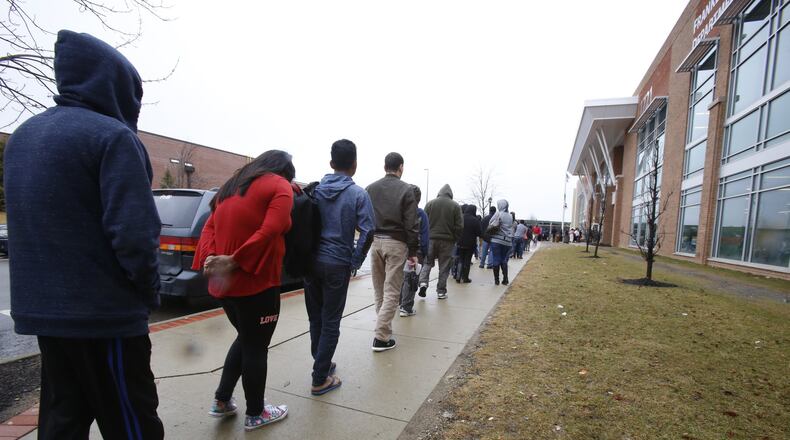At the current rate, the U.S. will take in less than half that number, which would be roughly a quarter of those granted entry in the final year of Barack Obama’s presidency.
In a letter to Catholic leaders last week, the United States Conference of Catholic Bishops — which handles about a quarter of all refugee settlements in the United States — said 9,616 refugees were resettled in the first half of the 2018 fiscal year, putting the program on pace to admit fewer than 20,000 for the year.
FROM WHIO: Refugees of the Miami Valley "For 37 years, the U.S. has been proud to be the world leader in welcoming and resettling these most vulnerable refugees," the conference officials wrote in a letter to the Department of Homeland Security. "Refugees are more than just numbers and statistics. They are our neighbors, our friends, our fellow parishioners, and our brothers and sisters in Christ."
Refugee services in Dayton are run by Catholic Social Services of the Miami Valley. That agency brought in 250 refugees to the region during fiscal year 2017, but was told the local target for 2018 would be just 130.
They are on pace to hit that number with 70 refugees resettled here since October — the bulk of them coming from the Democratic Republic of Congo. In addition to the 56 from that African country, the agency brought in three from the Ivory Coast, three from Rwanda, four from Eritrea and four from Afghanistan.
Typically, about 70 percent of local refugees annually come from the the Democratic Republic of Congo, formerly called Zaire, said Mike Lehner, director of marketing and development for Catholic Social Services of the Miami Valley.
About 10 percent annually have previously come from Iraq, but Lehner said the agency knew going into this year that no one would be coming from Iraq, Chad or Sudan due to the federal ban.
UNCERTAIN FATE: The effect of the Trump travel ban on Dayton-area families "We knew at the beginning of the year we'd have a lot less," Lehner said.
‘Pretty dramatic shift’
Columbus is one of the cities seeing a drop in refugee resettlements. The city is home to the nation’s largest population of Bhutanese refugees, most of whom are Buddhist or Hindu and were expelled during a government-led ethnic cleansing campaign against ethnic Nepalis in the early 1990s.
Columbus also has the nation’s second largest Somali refugee community, a group that is overwhelmingly Muslim. Somalia is one of the countries whose arrivals have been most sharply reduced.
In the first two months of this year, the U.S. accepted 49 refugees from Somalia, 19 from Iraq and five from Syria. That is down sharply from the 1,094 Somalis, 1,860 Iraqis and 1,991 Syrian refugees admitted in the first two months of 2017.
INTERACTIVE TIMELINE: Native countries of refugees living in Dayton "There's certainly a pretty dramatic shift" in the mix and number of refugees being allowed in, said Kathleen Newland, a fellow at the Migration Policy Institute, a Washington, D.C., think tank.
The administration is also cutting the nation’s resettlement system itself, telling executives of nine private agencies that facilitate resettlement they must close any office expected to place fewer than 100 refugees this year.
Because CSS is expected to bring in 130 people this year, the local agency was not on the chopping block, but other local branches under the USCCB Migration and Refugee Services umbrella were closed, Lehner said.
Locally, fewer refugees has meant less funding and a reduction in staff from 12 to five employees since the start of the new administration, Lehner said.
Humanitarian crisis
Excluding refugees from countries on the ban list has had a huge impact on the ethnic and religious makeup of the people coming to this country, said Newland. About 15 percent of refugees admitted to the U.S. this fiscal year are Muslim, down from 47 percent a year ago, federal figures show.
WATCH: What is the vetting process for immigrants and refugees? U.S. officials say there is no preference for refugees of one religion over another: "The United States is committed to assisting people of all religions, ethnicities, and nationalities who are fleeing persecution, violence, and other drivers of displacement," a State Department spokeswoman said in a written response to questions. The administration resumed the program to reunify refugee families in December, she said.
Trump’s policies have sharply cut refugee arrivals to many other Ohio cities. In Toledo the resettlement agency US Together had taken in 180 Syrians since 2014. Since last July, though, there has not been a single new arrival from the country, program director Corine Dehabey said.
Laura Roesch, CEO of Catholic Social Services of the Miami Valley, said the reductions are disheartening.
“There are still 65 million people displaced around the world, and we do have the capacity to bring in more people,” she said. “It’s a humanitarian crisis that’s worldwide.”
By the numbers:
45,000: Number of refugees the U.S. agreed to bring in during fiscal year 2018.
9,616: Refugees resettled in the U.S. in the first six months of the fiscal year.
250: Refugees resettled in the Dayton area in 2017 fiscal year.
130: Refugees planned to be resettled in Dayton area this year.
70: Refugees resettled in Dayton area in the past six months.
Source: United States Conference of Catholic Bishops
